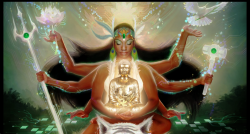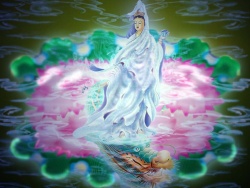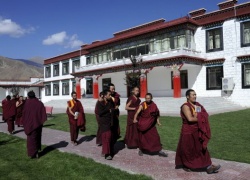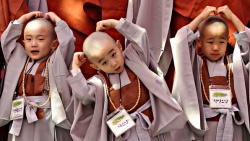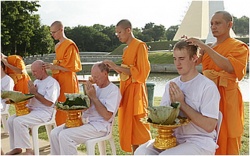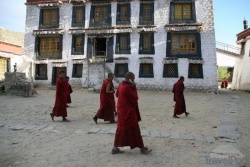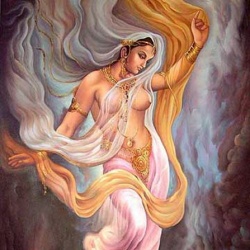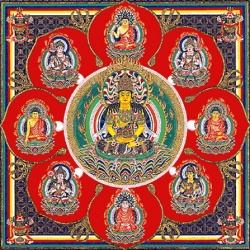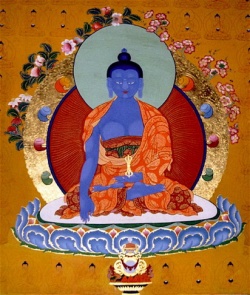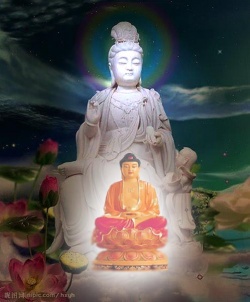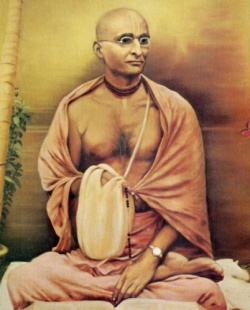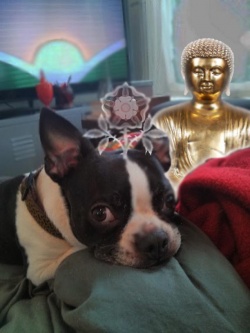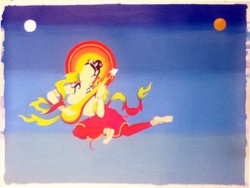Lineage (Buddhism)
A lineage in Buddhism is a line of transmission of the Buddhist teaching that is "theoretically traced back to the Buddha himself." The acknowledgement of the transmission can be oral, or certified in documents.
Several branches of Buddhism, including Zen and Tibetan Buddhism maintain records of their historical teachers. These records serve as a validation for the living exponents of the tradition.
The historical authenticity of Buddhist lineage is questionable. Stephen Batchelor has claimed, speaking about specifically Japanese Zen lineage, "the historicity of this “lineage” simply does not withstand critical scrutiny."
Erik Storlie has noted that transmission "is simply false on historical grounds." Edward Conze said "much of the traditions about the early history of Ch’an are the inventions of a later age."
Vinaya
In the lineage of the vinaya, the requirements for ordination as a monk or a nun include the presence of at least five other monks, one of whom must be a fully ordained preceptor, and another an acharya (teacher).
This lineage for ordaining nuns became extinct in many Buddhist countries.
When Ani Tenzin Palmo wanted full ordination for example, she had to travel to Hong Kong to receive it.
Mahasiddha
Lineages in the Mahasiddha tradition do not necessarily originate from the historical Gautama Buddha, but are ultimately grounded, like all Buddhist lineages, in the primordial Dharmakaya Buddha.
Chán and Zen lineages
- Main articles: Zen lineage charts and Dharma transmission
Construction of lineages
The idea of a patriarchal lineage in Ch'an dates back to the epitaph for Fărú (法如 638–689), a disciple of the 5th patriarch Hóngrĕn (弘忍 601–674).
In the Two Entrances and Four Acts and the Continued Biographies of Eminent Monks, Daoyu and Huike are the only explicitly identified disciples of Bodhidharma.
The epitaph gives a line of descent identifying Bodhidharma as the first patriarch.
In the 6th century biographies of famous monks were collected. From this genre the typical Ch'an-lineage was developed:
- These famous biographies were non-sectarian. The Ch'an biographical works, however, aimed to establish Ch'an as a legitimate school of Buddhism traceable to its Indian origins, and at the same time championed a particular form of Ch'an.
Historical accuracy was of little concern to the compilers; old legends were repeated, new stories were invented and reiterated until they too became legends.
D.T. Suzuki contends that Ch'an's growth in popularity during the 7th and 8th centuries attracted criticism that it had "no authorized records of its direct transmission from the founder of Buddhism" and that Ch'an historians made Bodhidharma the 28th patriarch of Buddhism in response to such attacks.
Six patriarchs
The earliest lineages described the lineage from Bodhidharma to Huineng. There is no generally accepted 7th Chinese Patriarch.
The principle teachers of the Chan and Zen traditions are commonly known in English translations as Patriarchs, however the more precise terminology would be "Ancestors" or "Founders" (祖, zu3) and "Ancestral Masters" or "Founding Masters" (祖師, zu3shi1) as the commonly used Chinese terms are gender neutral. Various records of different authors are known, which give a variation of transmission lines:
| The Continued Biographies of Eminent Monks Xù gāosēng zhuàn 續高僧傳 of Dàoxuān 道宣 (596-667) |
The Record of the Transmission of the Dharma-Jewel Chuán fǎbǎo jì 傳法寶記 of Dù Fěi 杜胐 |
History of Masters and Disciples of the Laṅkāvatāra-Sūtra Léngqié shīzī jì 楞伽師資紀記 of Jìngjué 淨覺 (ca. 683 - ca. 650) |
The Xiǎnzōngjì 显宗记 of Shénhuì 神会 | |
| 1 | Bodhidharma | Bodhidharma | Bodhidharma | Bodhidharma |
| 2 | Huìkě 慧可 (487? - 593) | Dàoyù 道育 | Dàoyù 道育 | Dàoyù 道育 |
| Huìkě 慧可 (487? - 593) | Huìkě 慧可 (487? - 593) | Huìkě 慧可 (487? - 593) | ||
| 3 | Sēngcàn 僧璨 (d.606) | Sēngcàn 僧璨 (d.606) | Sēngcàn 僧璨 (d.606) | Sēngcàn 僧璨 (d.606) |
| 4 | Dàoxìn 道信 (580 - 651) | Dàoxìn 道信 (580 - 651) | Dàoxìn 道信 (580 - 651) | Dàoxìn 道信 (580 - 651) |
| 5 | Hóngrěn 弘忍 (601 - 674) | Hóngrěn 弘忍 (601 - 674) | Hóngrěn 弘忍 (601 - 674) | Hóngrěn 弘忍 (601 - 674) |
| 6 | - | Fǎrú 法如 (638-689) | Yuquan Shenxiu 神秀 (606? - 706) | Huìnéng 慧能 (638-713) |
| Yuquan Shenxiu 神秀 (606? - 706) 神秀 | Xuánzé 玄賾 | |||
| 7 | - | - | - | Xuánjué 玄覺 (665-713) |
Continuous lineage from Shakyamuni Buddha
Eventually these descriptions of the lineage evolved into a continuous lineage from Śākyamuni Buddha to Bodhidharma.
The idea of a line of descent from Śākyamuni Buddha is the basis for the distinctive lineage tradition of the Chán school.
According to the Song of Enlightenment (證道歌 Zhèngdào gē) by Yǒngjiā Xuánjué (665-713),[10] one of the chief disciples of Huìnéng, Bodhidharma was the 28th Patriarch of Buddhism in a line of descent from Śākyamuni Buddha via his disciple Mahākāśyapa:
- Mahakashyapa was the first, leading the line of transmission;
- Twenty-eight Fathers followed him in the West;
- The Lamp was then brought over the sea to this country;
- And Bodhidharma became the First Father here
- His mantle, as we all know, passed over six Fathers,
- And by them many minds came to see the Light.[11]
The Transmission of the Light gives 28 patriarchs in this transmission,[12][13] and 53 overall:
Transmission to Japan
Twenty-four different Zen-lineages are recorded to be transmitted to Japan. Only three survived until today. Sōtō was transmitted to Japan by Dogen, who travelled to China for Chan training in the 13th century CE.
After receiving Dharma transmission in the Caodong line he returned to Japan and established the Sōtō line.
The Linji line was also transmitted to Japan several times, where it became known as the Rinzai line.
Jodo Shinshu
In Jodo Shinshu the term patriarch refers to seven Indian, Chinese and Japanese masters before its founder Shinran.
Tibetan Buddhism
Karma Kagyu
Possession of lineage
Wallace[14] renders into English a citation of Chagmé (Wylie: karma-chags-med, fl. 17th century) that contains an embedded quotation attributed to Nāropā (956-1041 CE):
- The crucial, primary qualification of a spiritual mentor is stated by Naropa, "The qualification of a spiritual mentor is that [t]he[y][(s/he)] possesses the lineage."
- The Single Meaning of the Vajra Speech Wylie: rDo rje'i gsungs dgongs pa gcig pa states, "There is great profundity in the connection within the lineage of the holy Dharma." The real lineage of the realization of this Dharma, which transfer blessings,[a] is the unbroken rosary of Buddhas...".[16]
Preservation of lineages
Gyatrul (b. 1924),[17] in a purport to Chagmé (Wylie: karma-chags-med, fl. 17th century), conveys Khyentse's 'samaya' (Sanskrit), diligence and humility in receiving 'wang' (Tibetan), lineal transmission and 'rlung' (Wylie) as rendered into English by Wallace (Chagmé et al., 1998: p. 21):
- With respect to oral transmission, even if the lineage is impure, it is not a problem. Dilgo Khyentse Rinpoche often sought out and received any oral transmission he thought was on the verge of disappearing. It made no difference who was giving it. He would receive it and, in turn, pass it on to make sure that the lineage remained unbroken.
Chöd lineage
Chöd is an advanced spiritual practice known as "Cutting Through the Ego." This practice, based on the Prajnaparamita sutra, uses specific meditations and tantric ritual.
There are several hagiographic accounts of how chöd came to Tibet. One namthar, or spiritual biography, asserts that shortly after Kamalashila won his famous debate with Moheyan as to whether Tibet should adopt the "sudden" route to enlightenment or his own "gradual" route,
Kamalashila enacted phowa, transferring his mindstream to animate a corpse polluted with contagion in order to safely move the hazard it presented. As the mindstream of Kamalashila was otherwise engaged, a Mahasiddha by the name of Padampa Sangye came across the vacant kuten or "physical basis" of Kamalashila.
Padampa Sangye was not karmically blessed with an aesthetic corporeal form, and upon finding the very handsome and healthy empty body of Kamalashila, which he assumed to be a newly dead fresh corpse, used phowa to transfer his own mindstream into Kamalashila's body.
Padampa Sangye's mindstream in Kamalashila's body continued the ascent to the Himalaya and thereby transmitted the Pacification of Suffering teachings and the Indian form of Chöd which contributed to the Mahamudra Chöd of Machig Labdrön.
The mindstream of Kamalashila was unable to return to his own kuten and so was forced to enter the vacant body of Padampa Sangye.
Source
